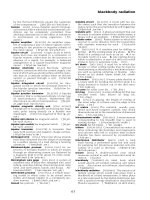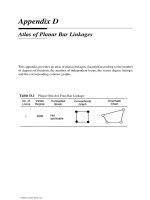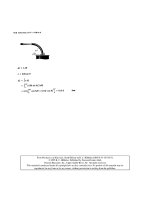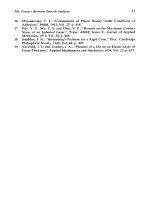Handbook of Lubrication Episode 1 Part 4 doc
Bạn đang xem bản rút gọn của tài liệu. Xem và tải ngay bản đầy đủ của tài liệu tại đây (759.24 KB, 19 trang )
NOMENCLATURE
AWN = AntiWear Number = —log
l0
k = log
l0
(1/k)
A = Area of apparent load support
A
r
= Area of asperity load support
A
w
= Area being worn
B = Surface profile correlation distance
c = Width of load support area in direction of motion
d = Depth of material worn from surface
E′ = Relative effective elastic modulus, 2 E′
1
E′
2
/(E′
1
+ E′
2
)
= Young modulus of elasticity/(1 — Poisson ratio)
2
F
P
,F
s
= Plowing friction force, shear friction force
f,f
b
,f
ss
= Friction coefficient, beginning, and steady-state friction coefficients
h = Thickness of rheodynamic film between asperities
H = Hardness of surface in stress units [multiply Brinell, Knoop, or Vickers
hardness numbers by 9.807 to convert to MN/m
2
(MPa) from the normal
hardness number units which are kg force/mm
2
]
k,k
b
,k
ss
= Wear coefficient, beginning, and steady-state wear coefficients
L = Face width of line contact
ᐉ, ᐉ
b
= Sliding distance, break-in sliding distance
n = Number of times surface passes through loaded area
P = Apparent pressure on load support area = W/A
P
e
,P
p
= Average pressure on elastically, plastically deformed asperity
r = Asperity tip radius
U = Sweep velocity of surface through load support area
U
s
= Sliding velocity (vector difference of sweep velocities of two surfaces
through load support area)
V = Volume of material worn from a surface
V = U
s
= sliding speed
W = Load normal to load support area
η = Viscosity
Λ = Film thickness parameter: ratio of fluid film thickness to composite rough-
ness of wearing surfaces (or to “diameter” of particles in fluid film if they
are larger than three times the composite surface roughness)
σ = Root mean square surface roughness (for two surfaces in contact, composite
roughness is square root of sum of squares of the RMS roughness of the
two surfaces)
τ = Shear stress
ψ = Plasticity index
REFERENCES
1. Bowden, F. P. and Tabor, D., The Friction and Lubrication of Solids, Oxford University Press, London,
1954.
2. Archard, J. F., Wear theory and mechanisms. ASME Wear Control Handbook, Peterson, M, B. and Winer,
W. O., American Society of Mechanical Engineers, New York, 1980.
3. Fein, R. S., Boundary lubrication, Lubrication, 57, 1, 1971.
4. Niemann, G., Rettig, H., and Lechner, G., Scuffing tests on gear oils in FZG apparatus, ASLE Trans.,
4, 71, 1961.
Volume II 67
Copyright © 1983 CRC Press LLC
5. Asseff, P. A., Study of corrosivity and correlation between chemical reactivity and load-carrying capacity
of oils containing extreme pressure agents, ASLE Trans., 9, 86, 1966.
6. Fein, R. S., Chemistry in concentrated-conjunction lubrication, in Interdisciplinary Approach to the Lu-
brication of Concentrated Contacts, NASA SP-237. Ku, P. M., Ed., U.S. Government Printing Office,
Washington. D.C., 1970, 489.
7. Fein, R. S., Rand, S. J., and Caffrey, J. M., Radiotracer measurements of elastohydrodynamic and
boundary films, Conf. Limits of Lubr., Imperial College, London, July 1973.
8. Blair, S. and Winer, W. O., A rheological model for elastohydrodynamic contacts based on primary
laboratory data. ASLE/ASME Lubr. Conf., Minneapolis, Minn., October 1978.
9. Archard, J. F. and Cowking, E. W., Elastohydrodynamic lubrication at point contacts, in Elastohydro-
dynamic Lubrication, Institute of Mechanical Engineers, London, 1965 and 1966, 47.
10. Dowson, D., Elastohydrodynamic lubrication, in Interdisciplinary Approach to the Lubrication of Concen-
trated Contacts, NASA SP-237, Ku, P. M., Ed., U.S. Government Printing Office, Washington, D.C.,
1970, 27.
11. Fein, R. S. and Kreuz, K. L., Discussion on boundary lubrication, in Interdisciplinary Approach to
Friction and Wear, NASA SP-181, Ku, P. M., Ed., U.S. Government Printing Office, Washington, D.C.,
1968, 358.
12. Fein, R. S., Friction effect resulting from thermal resistance of solid boundary lubricant, Lubr. Eng., 27,
190, 1971.
13. Archard, J. F., The temperature of rubbing surfaces, Wear, 2, 438, 1958-9.
14. Peterson, M. B. and Winer, W. O., Eds., ASME Wear Control Handbook, American Society of Me-
chanical Engineers, New York, 1980.
15. Anon., Scoring Resistance of Bevel Gear Teeth, Gear Engineering Standard, Gleason Works, Rochester,
N.Y., 1966.
16. Kelley, B. W. and Lemanski, A. J., Lubrication of involute gearing, in IME Conf. Lubr. Wear Fundam.
Appl. Design, London, September 1967.
17. Ku, P. M., Staph, H. E., and Cooper, H. J., On the critical contact temperature of lubricated sliding-
rolling disks. ASLE Trans., 21, 161, 1978.
68 CRC Handbook of Lubrication
Copyright © 1983 CRC Press LLC
HYDRODYNAMIC LUBRICATION
H. J. Sneck and J. H. Vohr
FLUID FILM LUBRICATION
“Lubrication theory” begins with the Navier-Stokes equations and the continuity equation.
Employing simplifications consistent with hydrodynamic lubrication, the end result is a set
of relatively simple working equations which describe the velocity and pressure distribution
throughout the flow field.
Assumptions which are made in lubrication theory are as follows. (1) the fluid film is
very thin compared to its extent, (2) effects of gravity are negligible, (3) viscosity does not
vary across the fluid film thickness, (4) curvature of the surfaces in journal bearings is large
compared to the fluid film thickness, (5) the fluid adheres to solid boundaries with no slip,
and (6) fluid inertia is negligible.
Reynolds Equation
The following equation which governs the pressure distribution within the fluid film is
named after Osborne Reynolds who first derived it. Using the notation of Figure 1:
(1)
Several simplifications can be made. It is usually possible to arrange the coordinate system
so that V
1
= V
2
= 0, thereby eliminating the first right side term. Further, writing U
1
+
U
2
= U and taking x to be in the direction of U
1
and U
2
yields
(2)
The first term on the right side of this equation indicates how the bearing surface motion
combines with density gradients and the wedge action of the fluid film thickness to generate
the pressure field. If the bearing walls are permeable, the net flow of fluid (w
h
– w
o
)
through the porous walls contributes to the generation of pressure by the second right side
term. The last term on the right side is the squeeze film term which relates density and film
thickness variation with time and the fluid film pressure.
Usually the complete Reynolds equation is not needed for a specific problem. For incom-
pressible fluids in bearings with impermeable walls (w
h
= w
o
= 0), for instance, density
drops out and then
(3)
Alist of further simplifying conditions and the terms affected is provided in Table 1.
Infinite SliderBearing
Abetter understanding of fluid film lubrication can be gained from a few simple bearing
configurations. The infinitely long slider bearing shown in Figure 2 is one of these. The
Volume II 69
Copyright © 1983 CRC Press LLC
Short Journal Bearing
The three factors essential for a hydrodynamic slider bearing (velocity, viscosity, and a
converging film) are all contained in the right side term of the Reynolds equation 6 µU(dh/
dx). The required convergent film is also formed when a shaft and bushing become eccentric
as shown in Figure 3b.
The unwrapped film shape is shown in Figure 3c. A positive superambient pressure is
generated in the convergent left portion of the film. Since liquids cannot withstand substantial
subambient pressure, the fluid film ruptures in the divergent right section, forming discon-
tinuous streamers which flow through this region at approximately ambient pressure. These
streamers contribute nothing to load carrying capacity.
When the bearing is “narrow”, i.e., its length is less than its diameter, Reynolds equation
can be simplified to
(8)
Neglecting the pressure gradient term for the x direction attributes circumferential flow
primarily to the motion of the journal surface expressed by the right side of the equation.
Axial flow and leakage are due entirely to the pressure gradient term on the left side of the
equation.
This “short bearing” version of Reynolds equation can be integrated twice in the y
direction, because h is not a function of y, to give the pressure function
(9)
72 CRC Handbook of Lubrication
FIGURE 3. Journal bearing oil-film relations.
Copyright © 1983 CRC Press LLC
Table 3
SHORT JOURNAL BEARING
where y is measured from the bearing center plane. This distribution satisfies the pressure
boundary conditions of P = 0 at both y = L/2 and y = –L/2.
Axial pressure distribution is shown by this equation to approach a simple parabolic shape.
Because the fluid film thickness is much smaller than the journal radius, h = c(1 – ⑀ cosθ).
When substituted into the pressure equation
(10)
Positive pressures are obtained in the convergent wedge portion between 0 and π. A rea-
sonably accurate prediction of load capacity can be obtained by setting the pressure equal
to zero in the divergent region between π and 2 π.
Retaining the axial pressure gradient term which accounts for axial flow allows a more
realistic treatment of axial pressure distribution than with the infinite slider bearing approx-
imation. Table 3 summarizes the performance characteristics of a short journal bearing. A
comprehensive table of integrals is available for use in solution of the sin-cos relations
commonly encountered with journal bearings.
1
When the shaft is lightly loaded, the eccentricity ratio, ⑀, approaches zero, The following
Petroff equation results from Table 3 and is frequently used to estimate journal bearing
power loss.
(11)
Cylindrical Coordinates
Reynolds equation in cylindrical coordinates (used in analysis of circular thrust bearings)
is
(12)
where U
r
and V
φ
, the radical and tangential surface velocities, play the same roles as U and
V in rectangular coordinates.
TURBULENCE
Very high speeds, large clearances, or low-viscosity lubricants may introduce a sufficiently
Volume II 73
Copyright © 1983 CRC Press LLC
high Reynolds number in a bearing film for departure from laminar flow velocity by either
of two instabilities: Taylor vortices or turbulence.
Taylor vortex flow is characterized by ordered pairs of vortices between a rotating inner
cylinder and an outer cylinder as shown in Figure 4.
2
Such vortices significantly “flatten”
the velocity profile between the cylinders and increase the wall shear stress. For a concentric
cylindrical journal bearing, vortices develop when the Taylor number ρUc√
___
c/r/μ exceeds
41.1.
3
For nonconcentric (loaded) bearings the situation is less clear, although studies have
recently been made.
4-8
Critical Taylor numbers are shown in Figure 5 as a function of
eccentricity.
7
Turbulence is a more familiar phenomenon. Unlike Taylor vortices, disordered flow in
turbulence is not produced by centrifugal forces and will occur whether the inner or outer
cylinder is rotating. In experimental studies where turbulence develops before Taylor vor-
tices,
9
turbulence appears to set in when the Reynolds number Re = ρUc/µ exceeds 2000.
74 CRC Handbook of Lubrication
FIGURE 4. Taylor vortices between con-
centric rotating cylinders with the inner cyl-
inder rotating. (From Schlichting, H.,
Boundary Layer Theory, 6th ed., McGraw-
Hill, New York. 1968. With permission.)
FIGURE 5. Critical Taylor number vs. eccentricity ratio. Experimental re-
sults for c/r = 0.00494. (From Frene J. and Godet, M., Trans. ASME Ser.
F, 96, 127, 1974. With permission.)
Copyright © 1983 CRC Press LLC
When vortices develop first, turbulence may begin at a lower value of Reynolds number.
4
Assuming that vortices develop when Re √
—
c/r = 41.1, vortices will occur before turbulence
for c/r ratios greater than 0.0004. In most bearings, however, turbulence sets in shortly after
the development of vortices; and since random turbulent momentum transfer appears to
dominate, turbulent lubrication theories have neglected the effect of vortices.
Turbulent lubricating film theories have been based on well-established empiricisms such
as Prandtl mixing length or eddy diffusivity.
10-12
Most commonly employed is that due to
Elrod and Ng
11
based on eddy diffusivity. Volume flows in the film are related to pressure
gradient through turbulent lubrication factors G
x
and G
y
, i.e.
(13)
(14)
where x refers to the circumferential direction and y axial. Flows
—
uh and
—
vh are obtained
from integrating velocities u and v across the film thickness. G
x
and G
y
depend upon the
level of turbulence as a function of local Reynolds number
—
Uh/vwhere
—
U is the local mean
fluid film velocity. For Couette flow Re
c
= Uh/v, where U is the bearing surface velocity,
while for pressure induced flow Re
p
= |P|h
3
/μvwhere |P| denotes the absolute magnitude of
the pressure gradient.
Using Equations 13 and 14 for lubricant flow rates, the turbulent Reynolds equation is
obtained:
(15)
While G
x
and G
y
depend, in general, upon the pressure gradient, they become functions of
Re
c
alone at very high surface velocities and high Re
c
In Figure 6, considering the curve
corresponding to Re
p
= 10
6
, G
x
at Re
c
= 2 × 10
4
joins an envelope of curves and becomes
independent of Re
p
provided Re
p
remains less than 10
6
and Re
c
remains greater than 10
4
.
For most hydrodynamic bearings, “linearized theory” with values of G
x
given by the
limiting envelope in Figure 6 suffices to describe turbulence.
13
Appropriate values of G
x
and G
y
are given by the following.
14
(16)
While various “fairing” procedures have been applied in the uncertain transition region
between laminar and turbulent flow,
15
the writer favors the following procedure. For values
of Re
c
less than 41.2 √
—
r/c (onset of vortices), laminar flow theory is to be used. For values
of Re
c
greater than 2000, fully developed turbulent relationships such as Equation 16 are to
be used. Between these critical values of Re
c
, linearly interpolate between the laminar values
for G
x
and G
y
(i.e., 1/12) and the values for G
x
and G
y
evaluated at Re
c
= 2000, with Re
c
being the interpolation variable.
A critical parameter affected by turbulence is the shear stress τ
s
acting on the sliding
member of a hydrodynamic bearing. For motion in the x direction, τ
s
under laminar flow
conditions is
(17)
Volume II 75
Copyright © 1983 CRC Press LLC
ENERGYEQUATION
Temperature distribution in the lubricant film is governed by the energy equation which
may be derived from the differential element of bearing film shown in Figure 9. The top
bounding surface is assumed stationary while the bottom surface moves with velocity U in
Volume II77
FIGURE 7. Load capacity of turbulent full journal bearing
for L/D = 1. (From Ng. C. W. and Pan, C. H. T., Trans.
ASME, 87(4), 675. 1965. With permission.)
FIGURE 8. Turbulent velocity parameters G
x
and G
y
vs. Re
p
when turbulence
is dominated by pressure-induced flow. (From Reddeclif, J. M. and Vohr, J. H.,
J. Luhr. Technol. Trans. ASME Ser. F, 91(3), 557, 1969. With permission.)
Copyright © 1983 CRC Press LLC
Work done on the lubricant by shear stress τ
s
at the moving surface is given by τ
s
UΔxΔy.
Equating net heat flow convected and conducted out of the control volume to work done
on the fluid, dividing through by Δx and Δy, taking the limit as Δx and Δy go to zero, and
applying the following continuity equation
(23)
results in the following overall energy balance
(24)
For laminar flow, the lubricant fluxes q
x
and q
y
are given by:
(25)
These expressions may be modified to take account of turbulence by means of the turbulent
flow factors G
x
and G
y
described earlier.
(26)
Stress τ
s
at the moving surface is given for laminar flow by the first of the following
relations, and is modified in the second case by turbulence factor C
f
discussed earlier.
(27)
Since Equation 24 depends upon the pressure gradient, it must be solved simultaneously
with the Reynolds equation. The usual procedure assumes an initially uniform temperature
(and viscosity) distribution to solve Reynolds equation for P(x,y); q
x
, q
y
, and τ
s
are then
determined from Equations 26 and 27. Equation 24 is then solved for T(x,y) and hence
µ(T). Reynolds equation is then resolved for pressure using the new distribution for viscosity.
This iterative procedure typically converges quickly.
Equation 24 requires specification of a bearing film inlet temperature. This temperature
is usually higher than that of the oil supplied to the bearing as a result of (1) heating as the
oil comes into contact with bearing metal parts, and (2) hot oil recirculation in and around
the bearing.
DYNAMICS
Three important concerns are commonly associated with the dynamic behavior of bearings:
(1) avoiding any bearing-rotor system natural frequencies, or “critical speeds”, near op-
Volume II 79
Copyright © 1983 CRC Press LLC
erating speeds, (2) limiting forced vibrations of the rotor-bearing system to acceptable levels,
and (3) freedom from self-excited “half frequency whirl” or “oil whip” instability.
Dynamic motion of a shaft in a fluid film bearing is illustrated in Figure 10. In general,
steady load W is balanced by steady film force F. Superposed dynamic loading W′(t) produces
dynamic shaft displacement x′(t) and y′(t) away from steady state position x
o
, y
o
, Corre-
sponding dynamic bearing film forces f
x
′(t) and f
y
′(t) may be calculated from Reynolds
equation since film thickness h and the time rate of change of h can be determined if x′,
y′, and v′
x
, and v′
y
are known.
From instantaneous film forces f
x
′(0 and f
y
′(t), dynamic motions of a rigid shaft of mass
M can be determined from the following equations of motion:
(28)
where W
x
′(t) and W
y
′(t) represent the x and y components of the externally imposed dynamic
loading on the shaft.
Since f
x
′(t) and f
y
′(t) are, in general, determined by a numerical solution of Reynolds
equations, Equations 28 may be solved numerically by a time integration procedure. This
“nonlinear transient analysis” does not involve the common simplifying assumption that a
linear relationship exists between shaft motions and the bearing film forces f
x
′ and f
y
′. This
transient approach is usually cumbersome and expensive since Reynolds equation must be
solved at each time step, and many cycles of shaft motion may need to be analyzed to define
rotor-bearing critical speeds, response to forced vibrations, and rotor bearing stability.
When using linearized stiffness and damping coefficients, shaft motions are assumed to
be sufficiently small that dynamic bearing forces f
x
′ and f
y
′ are linearly proportional to
journal displacements x′ and y′ and to journal velocities v
x
′ and v
y
′.
(29)
80 CRC Handbook of Lubrication
FIGURE 10. Dynamic motion of shaft.
Copyright © 1983 CRC Press LLC
(30)
Proportionality constants K
xx
, K
xy
, K
yx
, and K
yy
are referred to as bearing spring coefficients
while B
xx
, B
xy
, B
yx
, and B
yy
are bearing damping coefficients.
The usual computational procedure for determining the stiffness coefficients is to solve
Reynolds equation for bearing force components F
x
(x
o
y
o
) and F
y
(x
o
y
o
) with the journal steady-
state position x
o
,y
o
. For a very small shift, δ, of the journal in the x direction, bearing forces
F
x
(x
o
+ δ, y
o
) and F
y
(x
o
+ δ, y
o
) are then recalculated. Stiffness coefficients K
xx
and K
yx
are given approximately by:
(31)
K
xy
and K
yy
are similarly computed from a small journal displacement in the y direction.
Damping coefficients B
xx
, B
xy
, etc. are calculated by solving Reynolds equation to de-
termine the bearing squeeze film forces that arise due to journal velocities v
x
′ and v
y
′. For
incompressible lubricants, squeeze film forces are linearly proportional to squeezing velocity
provided boundary conditions for the pressure solution do not change.
Substituting Equations 29 and 30 into Equation 28 gives the equations of motion of a
rigid rotor supported in a fluid film bearing. Velocities v
x
′ and v
y
′ in Equations 29 and 30
are replaced by their equivalents dx′/dt and dy′/dt.
(32)
(33)
Coupled linear Equations 32 and 33 relate bearing dynamic motions x′ and y′ to the
imposed dynamic load components W
x
′(t) and W
y
′(t). Following four solutions of the
associated Reynolds equations to determine the eight stiffness and damping coefficients,
Equations 32 and 33 are then solved for “bearing response” and “bearing stability”.
Bearing Natural Frequency
Natural frequencies of a rigid rotor are those at which the rotor would tend to vibrate if
it were initially disturbed and then left free to return to steady state equilibrium. Natural
frequencies of rotor-bearing systems are referred to as critical speeds because large vibration
response is often experienced when running speed is the same as the natural frequency.
Mathematically, these natural frequencies for a single bearing are determined by equations
of motion 32 and 33 with dynamic forces W′
x
(t) and W′
y
(t) set equal to zero. The solution
to this set of equations may be expressed in the form:
(34)
where x* and y* are complex amplitudes which are not functions of time and where s =
λ
+
iv is a complex “frequency”. Acutal motion x′(t) is given by the real part of the
complex number formed by multiplying x* and e
st
. The last terms can be given as
(35)
Volume II 81
Copyright © 1983 CRC Press LLC
If we denote x* = α + iβ, then
(36)
Differentiating Equation 34 we find that
(37)
Thus we obtain from Equations 32 and 33
(38)
(39)
With the real part of the complex number inside the brackets forced to be zero, canceling
out the common term e
st
gives the following simultaneous equations for x* and y* in matrix
form.
(40)
According to linear equation theory, nonzero solutions for natural vibration amplitudes
x* and y* will be obtained if and only if the determinant of the left side matrix in Equation
40 is zero. This leads to the following characteristic equation for s:
(41)
Many “canned” computer routines are available for ready solution of this fourth order
polynomial equation for complex number s. Solutions for s occur in complex conjugate
pairs, i.e., the four solutions for s are
(42)
That is, dynamic vibration x′(t), in the absence of an external forcing function, will decay
back to an equilibrium state at a rate given by the exponential decay factor λ
1
and λ
2
, and
at frequency v
1
or v
2
. If the damping factor roots λ
1
and λ
2
are both negative, the bearing
is stable: free vibrations will tend to die out. On the other hand, if either λ
1
or λ
2
is positive,
then vibration will tend to grow without external excitation, an unstable condition.
For a simplified calculation of bearing natural frequencies, consider a bearing in which
cross-coupling stiffness terms K
xy
and K
yx
are zero. Tilting pad bearings satisfy this condition.
82 CRC Handbook of Lubrication
Copyright © 1983 CRC Press LLC
As a further simplification, neglect damping in the solution for v
1
and v
2
. This simplification
is valid for bearings having negligible cross-coupling stiffness and damping coefficients,
but is often not valid for fixed-arc bearings where the cross-coupling terms are significant.
With these simplifying assumptions, the bearing coefficient matrix becomes simply
The characteristic equation for s is
(43)
where solutions are
(44)
Referring to Equation 42 we see that our two natural frequencies are
(45)
which are the natural frequencies of two simple, uncoupled, spring-mass systems.
Bearing Response
When a rotor supported in a fluid film bearing is subjected to an arbitrary dynamic loading
W′(t), linearized response motions x′(t) and y′(t) would require numerical integration of
Equations 32 and 33. Frequently, however, dynamic loading is harmonic in nature and is
most commonly due to shaft unbalance. Such a rotating dynamic loading can be described
by the following equations:
(46)
where A is the amplitude of the loading and ω is the frequency. Substituting into Equations
32 and 33 we obtain
Volume II 83
Copyright © 1983 CRC Press LLC
(47)
(48)
The following particular solution for x′and y′satisfies the right-hand sides of Equations
47 and 48:
(49)
(50)
where:
Equations 49 and 50 give the forced vibration response solution to Equations 47 and 48
as distinct from the natural frequency or free vibration solutions discussed earlier. Both
forced and free vibration frequencies may be present in the total frequency spectrum of a
vibrating rotor. Unless the natural frequency vibrations are excited by random forces, how-
ever, they will decay exponentially with time for a stable bearing. Forced vibrations, how-
ever, will be sustained at the stable amplitudes given by Equations 49 and 50.
For some insight into bearing response, consider a simplified bearing for which cross-
coupling stiffness terms are zero and damping may be neglected. Equations 49 and 50 reduce
to:
(51)
When the dynamic loading frequency ωbecomes equal to one of the natural frequencies
as given by Equation 45, the response amplitude becomes infinitely large in either the x or
y direction.
For purpose of discussion, assume that K
yy
< K
xx
. For values of ωless than (K
yy
/M)
1/2
,
i.e., below the critical speed, Equations 51 yield the response orbit shown schematically in
Figure 11a. This ellipse is traced out by the center of the rotor whirling in the same direction
as shaft rotation. In this region, the y amplitude will always be greater than the x.
84 CRC Handbook of Lubrication
Copyright © 1983 CRC Press LLC
stiffness, K
R
, can be determined approximately by dividing the weight of the rotor by the mid-
span deflection resulting from that weight.
Figure 12 indicates the role played by the various bearing coefficients in stability. The
journal is shown whirling at the frequency v in a circular orbit of radius a about its equilibrium
position. At the instant depicted, the journal center is displaced in the x direction while the
velocity of the bearing center is in the y direction and given by dy/dt = va. If dynamic
forces acting on the journal in both the x and y directions are assumed to be in equilibrium,
the journal is just at the “threshold” of instability and the whirl orbit is neither growing or
decaying. Then
–K
yx
a = B
yy
va (y direction)
K
xx
a+B
xy
va = Mv
2
a (x direction) (56)
In the y direction, cross-coupling force – K
yx
a tending to drive the journal in whirl must be
balanced by damping term B
yy
va. In the x direction, restoring force, K
xx
a + B
xy
va, tending to
increase the orbit, must balance centrifugal force Mv
2
a which tends to increase the orbit. The
first equation determines the whirl frequency
v
=
–K
yx
/B
yy
(57)
Typically, for fixed arc bearings operating at light loads, v is very close to half the journal
rotational speed. As loading increases, v decreases as the bearing becomes more stable.
The equation for the x direction gives the “critical” shaft mass M
c
necessary for the system
to be at the threshold of instability:
86 CRC Handbook of Lubrication
FIGURE 12. Dynamic forces acting on whirling journal.
Copyright © 1983 CRC Press LLC
(58)
where v would be given by the preceding equation. If the actual shaft mass is less than M
c
,
the whirl orbit will diminish in amplitude (system is stable) while if the actual shaft mass
is larger, the system will be unstable.
The above analytical exercise is not valid because it considers only one point on the orbit.
In general, forces change as the shaft moves about the orbit and what happens “on average”
determines system stability. The exercise does identify, however, the role of cross-coupling
terms in promoting whirl, the type of balance which determines the whirl frequency ratio,
and a critical mass criterion for stability.
Design of Bearings For Optimum Dynamic Performance
Preceding equations provide tools for evaluating bearing dynamic behavior from stiffness
and damping coefficients. Fortunately, such data is being published for a variety of bearing
geometries (References 22 to 25). Some bearing types in common use are shown schemat-
ically in Figure 13.
26
The first two bearings, the plain journal and the four-axial groove,
are circular in shape. The arcs of elliptical and four-lobe bearings are displaced inwards
some fraction of the bearing clearance to introduce preload. In bearing (d), the bearing arcs
are displaced sideways for preload. Bearing (e) is usually circular but with a groove machined
over a portion of one of the bearing arcs, the circumferential end of the groove being a dam.
Tilting pad bearing (f) is the most stable of all and is commonly employed in high-speed
Volume II 87
FIGURE 13. Geometry for various bearing types. (From Allaire, P. E., in Fundamentals of the Design of
Fluid Film Bearings, Rhode, S. M., Maday, C. J., and Allaire, P. E., Eds., American Society of Mechanical
Engineers, New York, 1979. With permission.)
Copyright © 1983 CRC Press LLC
machinery. Since each arc is free to pivot, the center of pressure generated in each bearing
arc must be opposite the pivot point. Thus, if the shaft in Figure 13f moves directly down
toward the bottom pad, the resultant force acts directly up, eliminating the cross-coupling
force components which contribute to instability.
Stiffness and damping for fluid film bearings are usually presented in terms of a dimen-
sionless stiffness coefficient Kc/Wand a dimensionless damping coefficient ωBc/Wplotted
or tabulated as a function of either Sommerfeld Number S = (µNLD/W)(r/c)
2
or eccentricity
ratio ⑀ = e/c. Atypical plot of K
—
vs. S for an elliptical bearing is shown in Figure 14.
22
As load increases in Figure 14, S decreases and the cross-coupling coefficient K
yx
decreases
to provide increased stability. Acommon cure for unstable bearing designs is to increase
unit load W/LD by decreasing the bearing length.
Relative stability of some bearing types in Figure 15
26
is based on threshold of stability
analysis represented by Equations 52 to 54. In this case, stability results are plotted in terms
of a dimensionless critical mass
—
M
c
defined as ω√
—–——
cM
c
/W
–
. Figure 16 shows the corresponding
whirl ratio v
c
/ωat the threshold of instability.
88CRC Handbook of Lubrication
FIGURE 14. Elliptical bearing stiffness coefficients. L/D = 0.5; preload = 0.5. (From Allaire, P. E.,
Nicholas, J. C., Gunter, E. J., and Pan, C. H. T., Incompressible Fluid Film Bearings, U.S.A.F. Tech. Rep.
AFAPL-TR-78-6, Air Force Aero Propulsion Laboratory, Wright-Patterson Air Force Base, Ohio, March 1980.)
Copyright © 1983 CRC Press LLC
NOMENCLATURE
B = Bearing length
c = Journal bearing radial clearance
D = Journal diameter
e = Eccentricity
F
f
= Friction force
h
o
= Slider minimum film thickness
h
1
= Slider maximum film thickness
h = Film thickness
L = Bearing width
N = Rotational speed, cycles per second
P = Pressure
Q = Volumetric flow rate
q
x
= x-Component of lubricant flux
q
y
= y-Component of lubricant flux
r = Radius, radial coordinate
R
e
= Reynolds number, cUp/µ
t = Time
T = Temperature
u = x-Component of fluid velocity
U, U
1
, U
2
= x-Components of surface velocities
U
r
= Radial component of surface velocity in cylindrical coordinates
v = y-Component of fluid velocity
V, V
1
,V
2
= y-Components of surface velocities
V = Tangential component of velocity in cylindrical coordinates
w = z-Component of fluid velocity
W
—
= Load capacity
X = Center of pressure coordinates
∈ = Eccentricity ratio e/c
θ = Journal bearing angular coordinate
µ = Dynamic viscosity
ρ = Density
δ = Thrust bearing angular coordinate
ψ = Journal bearing attitude angle
ω = Angular velocity
v = Kinematic viscosity µ/ρ, vibration frequency
REFERENCES
1. Booker, J. F., A table of the journal-bearing integral, Trans. ASME Ser. D, 87, 533, 1965.
2. Schlichting, H., Boundary Layer Theory, 6th ed., McGraw-Hill, New York, 1968.
3. Taylor, G. I., Stability of a viscous liquid contained between two rotating cylinders, Philos. Trans. R.
Soc. London Ser. A, 223, 289, 1923.
4. Vohr, J. H., An experimental study of Taylor vortices and turbulence in flow between eccentric rotating
cyclinders, Trans. ASME Ser. F, 90, 285, 1968.
5. DiPrima, R. C. and Stuart, J. T., Non-local effects in the stability of flow between eccentric rotating
cylinders, J. Fluid Mech., 54, 393, 1972.
6. Mobbs, F. R. and Younes, M. A., The Taylor vortex regime in the flow between eccentric rotating
cylinders, Trans. ASME Ser. F, 96, 127, 1974.
90 CRC Handbook of Lubrication
Copyright © 1983 CRC Press LLC









